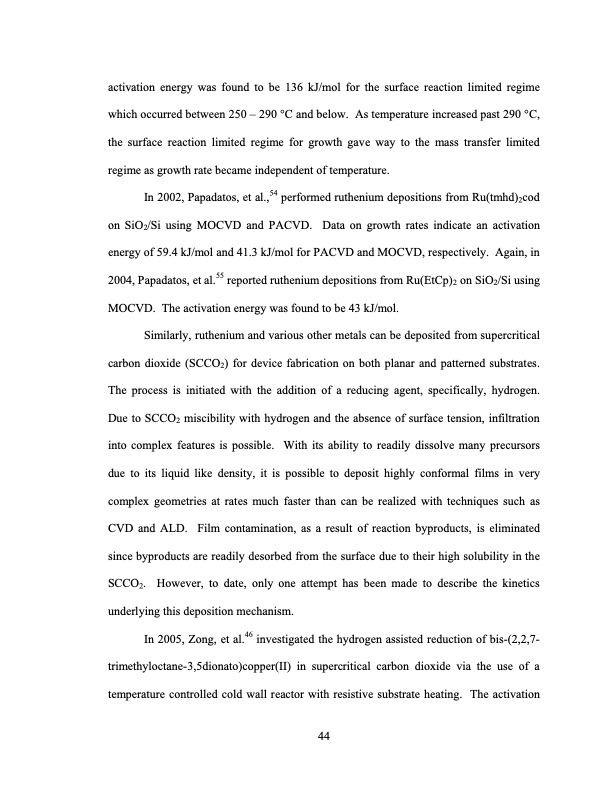
PDF Publication Title:
Text from PDF Page: 068
activation energy was found to be 136 kJ/mol for the surface reaction limited regime which occurred between 250 – 290 °C and below. As temperature increased past 290 °C, the surface reaction limited regime for growth gave way to the mass transfer limited regime as growth rate became independent of temperature. In 2002, Papadatos, et al.,54 performed ruthenium depositions from Ru(tmhd)2cod on SiO2/Si using MOCVD and PACVD. Data on growth rates indicate an activation energy of 59.4 kJ/mol and 41.3 kJ/mol for PACVD and MOCVD, respectively. Again, in 2004, Papadatos, et al.55 reported ruthenium depositions from Ru(EtCp)2 on SiO2/Si using MOCVD. The activation energy was found to be 43 kJ/mol. Similarly, ruthenium and various other metals can be deposited from supercritical carbon dioxide (SCCO2) for device fabrication on both planar and patterned substrates. The process is initiated with the addition of a reducing agent, specifically, hydrogen. Due to SCCO2 miscibility with hydrogen and the absence of surface tension, infiltration into complex features is possible. With its ability to readily dissolve many precursors due to its liquid like density, it is possible to deposit highly conformal films in very complex geometries at rates much faster than can be realized with techniques such as CVD and ALD. Film contamination, as a result of reaction byproducts, is eliminated since byproducts are readily desorbed from the surface due to their high solubility in the SCCO2. However, to date, only one attempt has been made to describe the kinetics underlying this deposition mechanism. In 2005, Zong, et al.46 investigated the hydrogen assisted reduction of bis-(2,2,7- trimethyloctane-3,5dionato)copper(II) in supercritical carbon dioxide via the use of a temperature controlled cold wall reactor with resistive substrate heating. The activation 44PDF Image | Supercritical Fluid Deposition Of Thin Metal Films

PDF Search Title:
Supercritical Fluid Deposition Of Thin Metal FilmsOriginal File Name Searched:
Supercritical-Fluid-Deposition-Of-Thin-Metal-Films-Kinetics-Mec.pdfDIY PDF Search: Google It | Yahoo | Bing
Sulfur Deposition on Carbon Nanofibers using Supercritical CO2 Sulfur Deposition on Carbon Nanofibers using Supercritical CO2. Gamma sulfur also known as mother of pearl sulfur and nacreous sulfur... More Info
CO2 Organic Rankine Cycle Experimenter Platform The supercritical CO2 phase change system is both a heat pump and organic rankine cycle which can be used for those purposes and as a supercritical extractor for advanced subcritical and supercritical extraction technology. Uses include producing nanoparticles, precious metal CO2 extraction, lithium battery recycling, and other applications... More Info
| CONTACT TEL: 608-238-6001 Email: greg@infinityturbine.com | RSS | AMP |